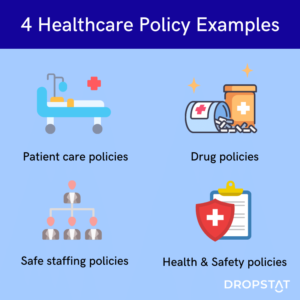Why implementing health care policies is vital
Healthcare facilities rely on effective guidance from health-related policies and procedures to create and sustain high-quality patient care. These policies provide a framework for nurses and staff by outlining expected standards for day-to-day operations and help facilities meet the many health and safety requirements in a high-risk industry.
Examples of healthcare policies
Patient care policies
Patient care policies include protocols and workflow for treatment procedures and outline how healthcare professionals should respond to specific medical situations such as exposure to bodily fluids. A patient care policy should also address the type of illnesses and injuries your facility treats, their medical procedures, and when to refer a patient or transfer them to another facility.
When creating a policy for patient care, no one size fits all. For example, a hospital’s pediatric and cardiology departments will have policies unique to their care practices.
Health and safety policies at the workplace
With your employees being your biggest asset, they need policies to protect their health and safety on the job. Depending on your facility, you may need a policy that covers PPE – personal protective equipment to protect your staff from exposure to chemicals, drugs, or infectious agents.
A comprehensive PPE policy should include the type of equipment necessary for different medical procedures, protocol for donning and removing the PPE, and how to safely dispose of the equipment.
Drug handling policies
Do you have any procedures that safeguard how medication is handled at your facility? Regardless of your healthcare facility type, you need very clear policies on how you administer medicine, how you record it, and what to do if medication goes missing.
Safe Staffing Policies
Establishing a policy of safe patient-to-nurse ratios is crucial to providing optimal patient care and lowering mortality rates. The policy should include a safe staffing ratio for all the departments in your facility. For example, the ICU nurse-to-patient ratio will be higher than in a lower-intensity ward. Similarly, the ratio in a cardiology department will differ from a Psychiatric department.
Dropstats’s workforce analytics can help you accurately determine your facility’s true staffing needs to establish a safe staffing policy by filling shift gaps in the most cost-effective way.
These are just a few examples of healthcare policies and procedures that must be in place in any healthcare system. But how can you successfully implement a healthcare policy in your facility? Dropstat explores the “top-down” or “bottom-up” approach.
How to create workplace policies within your healthcare system
The American Academy of Family Physicians notes , “Finding good clinical policies is only a first step; to improve care, they must be evaluated and implemented skillfully.”
Many policies that exist within the realm of healthcare are often implemented through a “top-down” or “bottom-up” approach.
The top-down approach
In the top-down approach to management, the decision-making process occurs at the highest level i.e. by project managers which filter down through a hierarchical structure to the rest of the team. Managers gather knowledge, analyze it, and draw actionable conclusions. They then develop procedures that are communicated to and implemented by the team.
The Bottom-up approach
The bottom-up approach considers staff that are lower down in the hierarchy and allows them to contribute to the policy’s goals and implementation. However, one difficulty with this method of policy enactment is that evaluating the policy’s efficacy becomes increasingly complex.
Finding the right approach to implementing policies in the healthcare system or researching policy strategy within the hospital setting is difficult since all public health policies were often enacted from a government standpoint and less frequently through feedback from medical workers.
From extensive experience with safe staffing policy implementation, Dropstat has found that the key to success in instituting a healthcare policy is prioritizing and incentivizing follow-through from the start. Creating clear policy guidelines along with incentives and accountability for implementation has a much higher success rate than constantly trying to bring your facility up to speed. Attempting to establish a system of implementation after the policies have been put in place is usually frustratingly ineffective.
How Dropstat’s automated scheduling policy successfully uses the top-down approach
- Schedulers must make sure shifts are posted on Dropstat 4-6 weeks in advance. This proper lead time will give staff ample time to pick up posted shifts.
- If a shift remains without staff awaiting approval for more than two weeks, a bonus amount of $50 may be added as an incentive.
- If a shift still remains unfilled one week before the start of the shift, an additional $50 may be added.
- On a daily basis, Schedulers will check for any shifts awaiting approval and approve appropriate staff members after reviewing the cost-effectiveness and seniority metrics.
The scheduler’s daily tasks ensure that the technology is working at its highest level of efficiency by allowing staff members to take advantage of available shifts, and by sustaining a routine for updating the shifts that are awaiting approval.
The terms regarding incremental increases in bonuses through the app also enable the facility to audit their expenses while ensuring maximum transparency and equal, appropriate compensation.
Conclusion
Establishing clear policies and procedures in healthcare facilities will ensure optimal patient care and protection for your staff. With clear guidelines in place, your nurses will have a framework for what is expected with the day-to-day running of the business and help you follow the required safety protocols in a high-risk industry.
Need help deciding which staffing policies are right for your facility? Get started with Dropstat to take one step closer to safer staffing.








